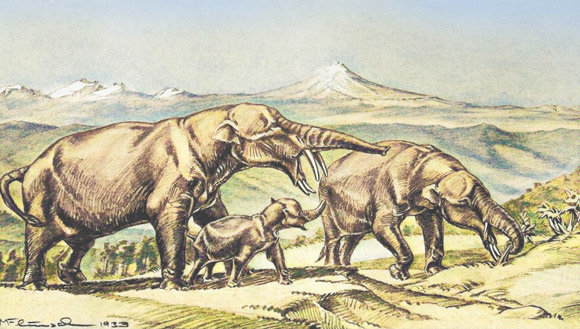Paleontologists have unearthed several complete skeletons of gomphotheres — an extinct relative of elephants — at the Montbrook Fossil Dig in Florida, the United States.
Gomphotheres were a diverse group of extinct elephant-like animals. They were smaller than mammoths — about the same size as modern elephants.
These creatures first evolved in Africa in the early Miocene, roughly 23 million years ago, after which they dispersed into Europe and Asia.
By 16 million years ago, they’d reached North America via the Bering land bridge, and when the Isthmus of Panama rose above the sea 2.7 million years ago, gomphotheres were waiting on the shoreline to cross into South America.
Along the way, they evolved several unique features that allowed them to thrive in the new environments they encountered.
“This is a once-in-a-lifetime find,” said Dr. Jonathan Bloch, curator of vertebrate paleontology at the Florida Museum of Natural History.
Dr. Bloch and his colleagues unearthed 5.5-million-year-old gomphothere skeletons — including one adult and at least seven juveniles — at a locality called the Montbrook Fossil Dig.
“It’s likely the fossils were successively deposited or transported to the area,” said Dr. Rachel Narducci, collection manager of vertebrate paleontology at the Florida Museum of Natural History.
“Modern elephants travel in herds and can be very protective of their young, but I don’t think this was a situation in which they all died at once.”
“It seems like members of one or multiple herds got stuck in this one spot at different times.”
The adult gomphothere skull (foreground, tusk capped in white plaster) was separated from the main body (background, covered in plaster) prior to its preservation. Image credit: Kristen Grace / Florida Museum of Natural History.
According to the paleontologists, the Montbrook gomphotheres belong to the genus Rhynchotheriumwhich was once widespread across North and Central America.
“We all generally know what mastodons and woolly mammoths looked like, but gomphotheres aren’t nearly as easy to categorize,” Dr. Narducci said.
“They had a variety of body sizes, and the shape of their tusks differed widely between species.”
“In addition to the usual pair of upper tusks common in proboscideans, some gomphotheres had a second set attached to the lower jaw, which were fashioned by natural selection into increasingly implausible configurations.”
“Many species had small lower tusks that splayed apart or extended in parallel at the tip of a significantly elongated jaw.”
“Tusks in the platybelodon gomphotheres were flattened and joined, resembling a massive pair of buck teeth, which they used to scrape bark from trees.”
The Montbrook discovery gives new life to Rhynchotherium gomphotheres and provides scientists with the opportunity to learn more about the charismatic fauna that once populated North America.
“A fossil site in southern California is the only other place in the U.S. that has produced a large sample of Rhynchotherium juveniles and adults,” Dr. Bloch said.
“We’re already learning so much about the anatomy and biology of this group that we didn’t know before, including new facts about the shape of the skull and tusks.”
Note: This article have been indexed to our site. We do not claim legitimacy, ownership or copyright of any of the content above. To see the article at original source Click Here















